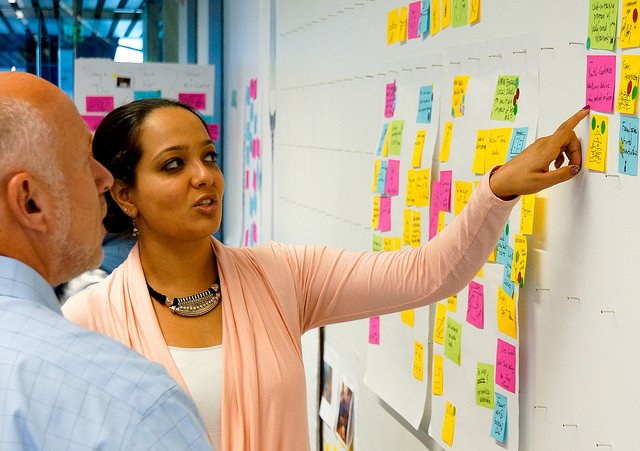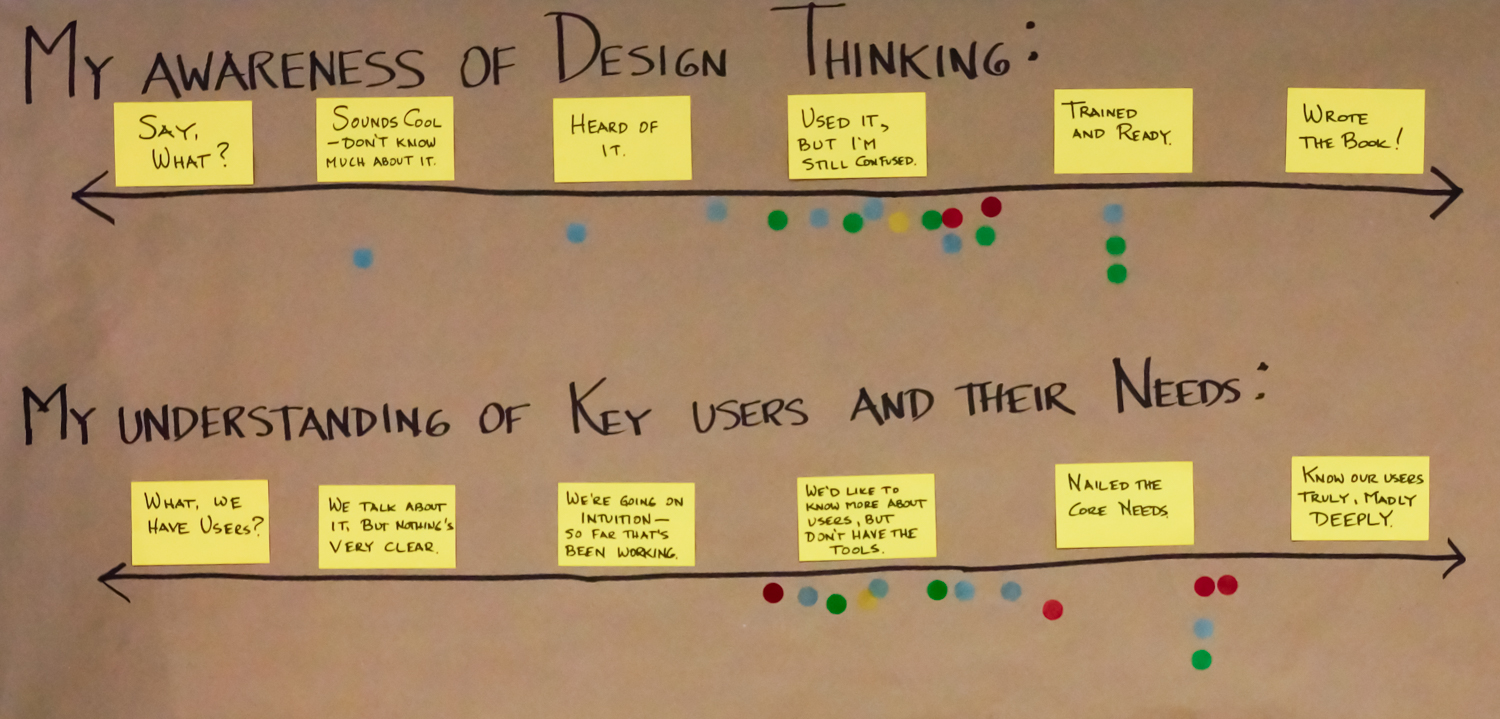
Design thinking for better philanthropy
Above: Terry Mazany of the Chicago Community Trust and Neha Singh Gohil of the Silicon Valley Community Foundation take part in a design thinking session for their projects. RELATED LINK
“Lessons Learned from the Local News Lab” on Geraldine R. Dodge Foundation web site, 2/11/2016
For the past two years, Knight has brought together four place-based foundations for human-centered design training to help them consider how their work in news and information can better benefit the community. Here, Molly de Aguiar, of the Geraldine R. Dodge Foundation, writes about how the experience impacted her work.
I was standing in front of a giant sheet of paper on the wall, trying to decide if I should bluff. I had a little sticker in my hand and I was supposed to put it on the sheet of paper to indicate how much I knew about human-centered design. Was I brand new to the concept, an expert already, or somewhere in between? I was sure everyone else was putting their dots close to the “Wrote the Book!” end. I thought I was the only one who didn’t know much.

From ‘Deep Dive on Design Thinking‘ session at Knight Foundation’s 2015 Media Learning Seminar.
That was a cold weekend in the fall of 2014, and those of us in the room didn’t quite know what to expect of that weekend or what lay ahead. Knight had invited four foundations deeply invested in community information initiatives – the Incourage Foundation, the Chicago Community Trust, the Silicon Valley Community Foundation, and the Geraldine R. Dodge Foundation – to come together as a cohort and learn design thinking over the course of a year and a half. The idea was to use the process to advance our the information and engagement projects Knight had funded. The training was a leap of faith for everyone, including Knight.
Turns out, I had a pretty deep intuition for human-centered design and just needed to learn some new techniques to help me incorporate it more deeply into my work helping to build a stronger news ecosystem in New Jersey. (You can read more about it in our report “Lessons from the Local News Lab: Building a More Connected and Collaborative News Ecosystem.”)
Human-centered design is another way of saying we need to put people at the heart of our work. It means adopting a mindset that continuously challenges assumptions we make about what we think we know in favor of embracing discovery and inquiry to better understand, and therefore better respond to issues and needs identified by people in the communities we serve. The emphasis here is what communities want, not what we as funders want or what we think they want. If ever there were a sector that should innately understand human-centered design, it’s the sector that literally means “love of mankind.”
What I discovered over the past 18 months is there are at least a couple of layers of design thinking that funders ought to consider:
1) How do we design our work so that we serve our applicants and grantees better? An obvious example: as a nonprofit goes through your application process, what is their user experience? Has it been designed with their input and feedback? Is the process overly burdensome and time consuming, or is it reasonably easy to navigate? Are you making them jump through too many hoops for a small grant?
There are many foundations that spend a lot of time thinking about how to make their process a good experience for applicants, whether or not they’ve ever heard of or know techniques of human-centered design. Understanding specific design thinking methods and tools, however, would enable foundations to improve our systems even further, build better relationships with the nonprofits we support, and also likely give us unexpected insight into other aspects of our work. 2) How do we design our work so that we serve our communities better? For example, your foundation may have clearly defined strategies for supporting community news and information projects which leads you to support the local nonprofit or public media news organization. But how do you know whether the news organization is covering issues that the community cares about? Is the news organization regularly asking the community what its concerns and priorities are, or are the reporters just covering whatever stories they think (guess) people want to read? Admittedly, these are often not easy questions to ask or conversations to have with local newsrooms. But one way to approach this situation is to help fund user-centered research on behalf of your local news organizations (something the Dodge Foundation did, in partnership with the Democracy Fund, for a handful of local newsrooms in New Jersey). Help them gain firsthand insight into their communities through focus groups.
No matter what the field or area of focus, if there’s a big disconnect between what the community wants and what the nonprofit is offering, your grant to that organization will not be successful. A design thinking mindset helps you see and choose organizations that care about community input and regularly build it into their work. In turn, this helps you as a funder understand the real needs of real people in the communities you serve.
My experience with the Knight-led cohort to learn human-centered design has transformed the way I approach my work. In addition to regularly revisiting whether the Dodge grantmaking process can be a better experience for applicants, I think about risk differently and try to incorporate more prototyping and shorter term pilot projects into my work. I challenge myself to come up with multiple potential solutions to the same problem which is part of the process and helps build my creative muscle. And I have a whole new array of interviewing techniques that can help me gain deeper and more meaningful insight into the challenges affecting the communities the Dodge Foundation serves throughout New Jersey.
Some 18 months ago, I put my dot next to “Heard of it,” but if you asked me today, I’d put that sticker next to “Trained and ready.” If you’re feeling as unsure as I was back then, know that there are many ways, big and small, to incorporate design thinking into your work and many resources out there to help you learn more. But even if you don’t have the opportunity or inclination to learn more specific design thinking skills, asking more questions about how your applicants are co-creating work with their communities (or not) will help you develop more successful community investments.
Molly de Aguiar (@MollydeAguiar) is the Program Director for Informed Communities at the Geraldine R. Dodge Foundation. de Aguiar and representatives of three other foundations who participated will be speaking at a breakfast Monday at the Media Learning Seminar in Miami.
Recent Content
-
Communitiesarticle ·
-
Communitiesarticle ·
-
Communitiesarticle ·


